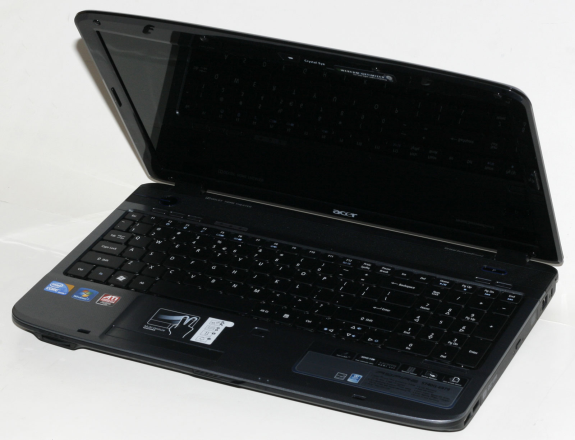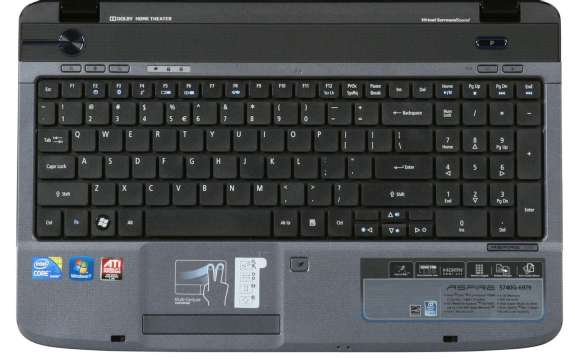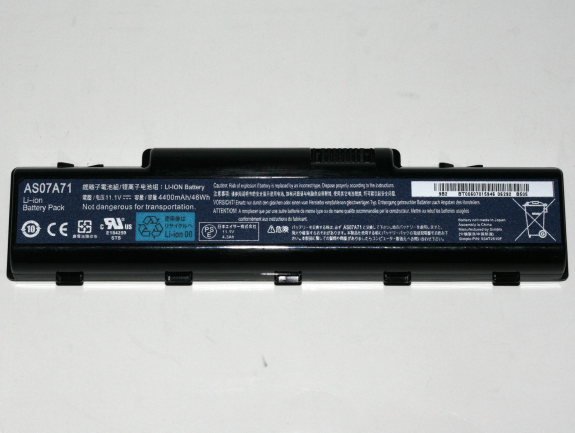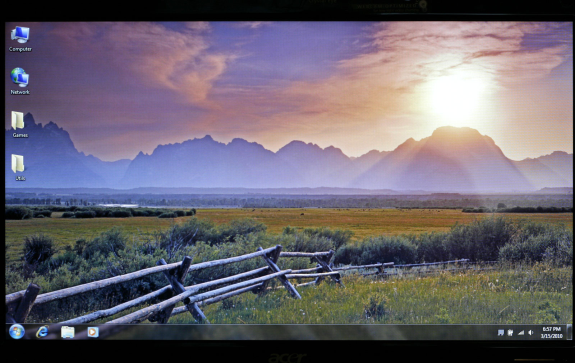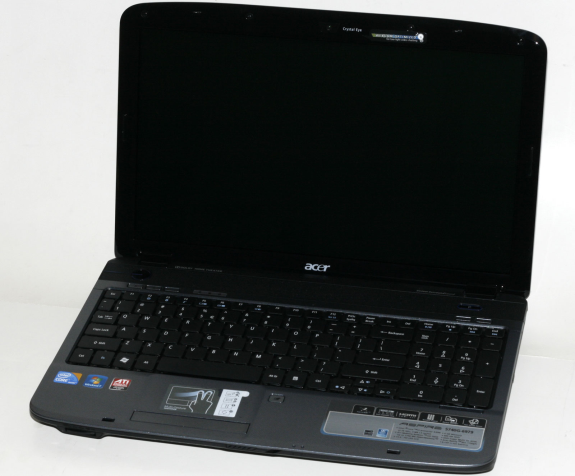
Original Link: https://www.anandtech.com/show/3631/acer-aspire-as5740g-6979-budget-priced-gaming
Acer Aspire AS5740G-6979: Budget Priced but Great Gaming
by Dustin Sklavos on April 2, 2010 7:39 PM ESTIn recent years, Acer has been doing an admirable job of condensing respectable hardware into affordable machines. Each successive generation, Acer has usually had one or two solid notebooks that were able to squeeze a decent gaming GPU into a reasonable price tag, and with the Aspire 5740-6979, that trend continues. Today we're able to take a look at a machine that features Intel's still relatively young Core i5 paired with – and this is the particularly compelling part – AMD's new mobile DirectX 11-class hardware.
Acer offers a wide variety of machines – all direct to retail – in their Aspire 5740 lineup, but the 6979 is one of only two models available off of Newegg. The other model, the 6395, trades up the processor to a 2.4 GHz model and raises the price from the 6979's $799 to $849 while reducing hard drive capacity by 180GB. Note that Buy.com and Provantage both list a price of $749, though it's out of stock at Buy.com and shows as a "special order" (i.e. ships from the manufacturer) for Provantage. If you're not in a rush, you could potentially save $50, but Newegg is otherwise a safe bet. Frankly, the 6979 we received for review should be the more attractive of the two: the modest bump in clock speed on the CPU isn't worth an extra $50 on the price tag and a loss of hard drive capacity.
| Acer Aspire 5740G-6979 Specifications | |
| Processor |
Intel Core i5 430M (2x2.26GHz, 32nm, 3MB L3, Turbo to 2.53GHz, 35W) |
| Chipset | Intel HM55 |
| Memory | 2x2GB DDR3-1066 (Max 2x4GB) |
| Graphics |
ATI Mobility Radeon HD 5650 1GB GDDR3 (400 SPs, 550/1.5GHz Core/RAM clocks) |
| Display | 15.6" LED Glossy 16:9 768p (1366x768) |
| Hard Drive(s) | 500GB 5400RPM HDD |
| Optical Drive | 8x DVDR SuperMulti |
| Networking |
Gigabit Ethernet Atheros AR5B93 802.11n V.92 56K Modem |
| Audio |
HD Audio (2 stereo speakers with line-in, mic and headphone jacks) Capable of 5.1 digital output |
| Battery |
6-Cell, 12V, 46Wh battery "Up to 3 Hours" |
| Front Side | Memory Card Reader (SD/MMC) |
| Left Side |
AC Power Connection Ethernet HDMI VGA 2 x USB 2.0 Line-in Jack Mic Jack Headphone Jack |
| Right Side |
2x USB 2.0 Optical Drive (DVDRW) Modem Jack Kensington Lock |
| Back Side | Exhaust vent |
| Operating System | Windows 7 Home Premium 64-bit |
| Dimensions | 15.1" x 9.9" x 1.03-1.5" (WxDxH) |
| Weight | 6.16 lbs (with 6-cell battery) |
| Extras |
Webcam 103-Key keyboard with 10-key Flash reader (MMC/MS/MSPro/SD) |
| Warranty | 1-year basic warranty |
| Pricing |
$748 Online $799 from NewEgg |
Digging in, we find that Acer's Aspire 5740-6979 is remarkably powerful for a notebook in its price range. The Intel Core i5 430M may be the slowest in Intel's mobile i5 lineup, but at 2.26 GHz (with a Turbo Boost speed of 2.53 GHz) and based on Intel's efficient Nehalem architecture it's still an extremely potent chip. Like the rest of the mobile Core i5's, it comes equipped with 3MB of L3 cache. Filling out the other side of the unit's double whammy is the AMD Mobility Radeon HD 5650 with a full 1GB of GDDR3 video memory. This should be the really interesting part: while the 5650 is the slowest of AMD's DirectX 11-class mobile GPUs before we get into the 80-shader 5400 series, it's still a robust part sporting higher specifications than last generation's Mobility Radeon HD 4670, a powerful mobile graphics processor in its own right. At a core clock of 550 MHz and running its GDDR3 at an effective 1.5 GHz on a 128-bit bus, the 5650 packed into the Aspire is basically a desktop Radeon HD 5570 running at reduced clocks. Despite the reduction, though, it still packs 400 shader processors, 20 TMUs, and 8 ROPs, which should be ample for the Aspire's 768p screen.
Unfortunately that performance comes at a cost, and that cost is battery life. The Aspire offers no way to switch to the integrated graphics built into the Core i5 430M, and while this feature would've added cost and complexity to the build of the Aspire 5740, it also highlights a feature NVIDIA has that AMD doesn't. NVIDIA's Optimus switchable-graphics technology makes a very convincing case for choosing a notebook with NVIDIA graphics, because while a notebook with a modern, Optimus-ready GeForce can easily switch back to integrated graphics and completely shut down the dedicated GPU to save power, AMD's Mobility Radeons are forced to rely on their own power-saving measures to preserve battery life. The 5000 series Radeons may be very efficient chips, but the best mode for conserving power is always going to be “off.”
The rest of the Aspire 5740 is less exciting but still healthy and modern. Acer packs the unit with 4GB of DDR3-1066 memory in two DIMMs (upgradeable to 8GB if you're willing to sacrifice the existing two sticks to the Gods of Online Auction Houses), a meaty 500GB hard drive running at 5400 RPM, and a DVD+/-RW drive. Networking options are short only Bluetooth (kind of a shame, really): Acer includes an Atheros 802.11n wireless networking adapter, a gigabit Ethernet port, and even a 56K modem (some people still fax out resumes.) To top it all off, there's a 1.3-megapixel webcam integrated into the screen bezel, right where you'd expect it.
If the hardware included in the Aspire 5740 is awesome for the price, the build of the machine is going to be where Acer cut corners. It's solid, sure, but the style is bulbous and bulky, and the plastic feels cheap. Connectivity is bog standard, and just as with the Dell Inspiron 15 review, we're disappointed with the lack of FireWire and eSATA connectivity. While the Radeon in the Aspire suggests what purpose the unit is meant to serve, it's a shame not to have included connectivity for media enthusiasts. Four USB 2.0 ports are all well and good for quantity, but you're still going to be backing up a 500GB hard drive at about 30MB/sec tops. And again, unfortunately like Dell, Acer omitted the ExpressCard port, thus preventing the user from expanding the unit's connectivity.
Thank goodness the Acer Aspire 5740 has a great personality, because it sure isn't a looker. The glossy blue lid's curves suffer from the “bulbosity” we mentioned before. While the dark blue is attractive, the glittery texturing is gaudy and the “Signal Up” logo in the corner always looks like a blemish until you look at the lid up close. And because the lid is glossy plastic, it's the kind of fingerprint magnet we've come to expect.
Before we even get to the insides, though, it's worth mentioning that the Aspire 5740 still uses a mechanical latch to hold the notebook shut. This was actually an initial source of embarrassing confusion: most modern notebooks have a mechanism to keep them shut in the hinge and are easy to open and close. You're probably familiar with it.
The inside of the Aspire 5740 isn't unattractive, but elements of it are still a bit ostentatious. The texturing on the gray plastic used for the palm rests and touchpad is comfortable, and the black matte plastic used for the speakers at the top of the unit is unassuming, but the big power button on the left side with the blue LED illumination is too much, and the “P” button on the right side could easily be confused for a power button. The right speaker is also closer to the center than the left speaker, making for slightly off stereo positioning—not that the speakers are worth using for any serious audio, as they tend to distort at higher volume levels. And then there are the power and battery indicator LEDs at the bottom lip, and the key lock indicators above the keyboard, the wireless toggle button that illuminates next to them...the design feels scattershot, lacking any kind of cohesion.
Looks may not be everything, but most damning may just be interfacing with the notebook itself. The screen is adequate for the price range, and the touchpad features multi-touch capability and is smooth and easy to use. Yet the keyboard, despite having an intelligent layout in cramming in the 10-key, wound up being even worse than it looked. Flex isn't an issue, but Acer's bizarre halfway-between-chiclet-and-standard keyboard is staggeringly uncomfortable to use and was enough to turn me off completely from purchasing any unit that uses it. The keys just feel strange and were alarmingly difficult to touch type on. If you're using the notebook principally to game then it shouldn't be a deal-breaker for you, but for any kind of serious writing it's something you will want to play with in the store and make absolutely certain you can live with.
The rest of the build is at least more sensible. USB ports are split evenly between the sides, and heat vents out of the back of the unit instead of on one of the sides and risking warming up the user's mousing hand. If nothing else, the Aspire 5740 is – if a bit cheap looking – a solid machine.
The 4GB of memory and quad-threaded Intel Core i5 430M processor may be on the high end of bog standard for modern notebooks, but remember that it's still a lot of power for a sub-$800 machine, especially when you factor in the Mobility Radeon HD 5650. A refresh of the configuration of our review unit:
|
Acer Aspire 5740G-6979 Testbed |
|
| Processor |
Intel Core i5 430M (2x2.26GHz, 32nm, 3MB L3, Turbo to 2.53GHz, 35W) |
| Memory | 2x2GB DDR3-1066 (Max 2x4GB) |
| Graphics |
ATI Mobility Radeon HD 5650 1GB GDDR3 (400 SPs, 550/1.5GHz Core/RAM clocks) |
| Display | 15.6" LED Glossy 16:9 768p (1366x768) |
| Hard Drive(s) | 500GB 5400RPM HDD |
| Optical Drive | 8x DVDR SuperMulti |
| Battery |
6-Cell, 12V, 46Wh battery "Up to 3 Hours" |
| Operating System | Windows 7 Home Premium 64-bit |
| Pricing |
$748 Online $799 from NewEgg |
While synthetics aren't ideal for gaming performance, for basic computing performance they can still be helpful. We tested the Aspire 5740 in PCMark05 and PCMark Vantage to see how it stacked up to some of the other units we've reviewed. Pay particular attention to the ASUS N61Jv and the Alienware M11x, which are two of the closest competitors in terms of providing reasonable gaming performance for under $1000. We've highlighted their results in the performance benchmarks for ease of comparison.
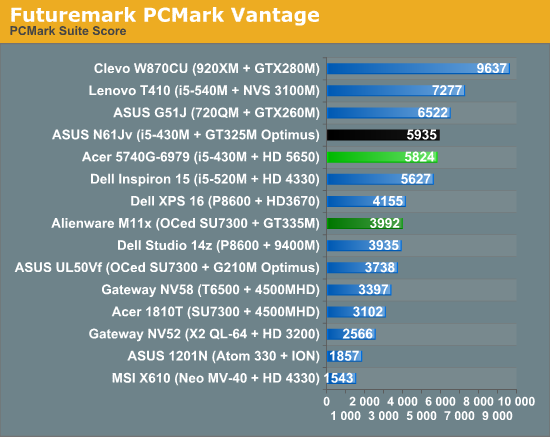

What's interesting to note here is the way the HD 5650 helps the Aspire score substantially higher than the Inspiron 15, a unit equipped with the next fastest processor from Intel. You can also see how much faster Core i5 is relative to Core 2 Duo and overclocked CULV (i.e. the M11x)—around 50% higher performance in PCMark. Another interesting point of reference is the ASUS G51J with a quad-core i7-720QM CPU; despite a default clock speed of just 1.6GHz, Turbo Mode is in full effect and the 720QM stays ahead of the Core i5 competition.
Rounding out our processor performance metrics are Futuremark's Peacekeeper browser benchmark, Cinebench 10, and an x264 encoding routine.
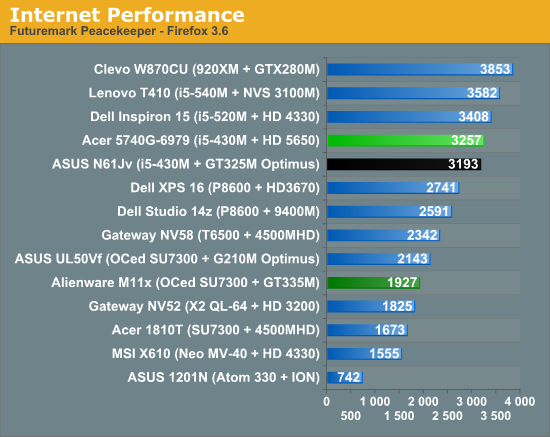
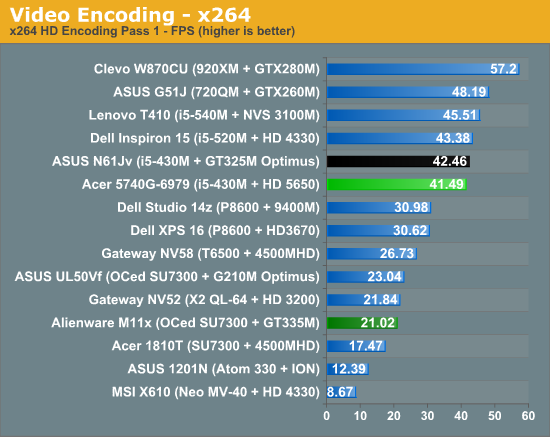
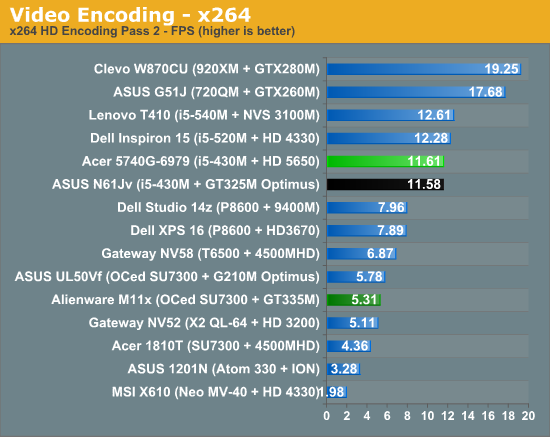

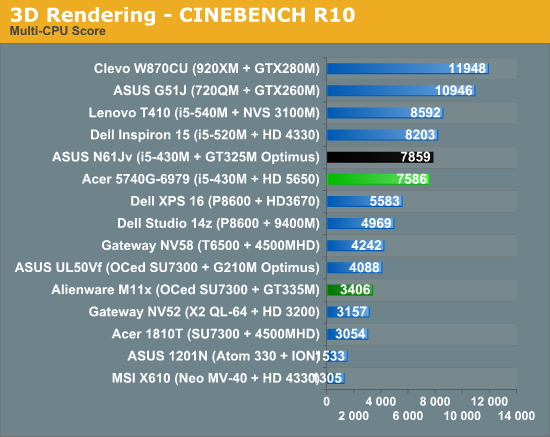
In each case, the Core i5 430M is hot on the heels of the slightly faster i5 520M in the Dell Inspiron 15, trailing by around 5%. The exception is Cinebench where performance is markedly lower. It's possible that the 300MHz gulf between the top turbo speeds of these two chips is manifesting here. Either way, the single-CPU test is 12% slower and the multi-core test is 8% slower. As seen in PCMark, an i7-720QM maintains a comfortable lead over the i5 CPUs as well with its more aggressive Turbo Modes. Only the i5-540M is able to keep up with the 720QM in the single-CPU Cinebench result, while the multithreaded score is substantially higher.
AMD's Mobility Radeon HD 5650 may be the slowest of its mainstream mobile graphics, but as you'll see in the moment it's still quite a demon for a mobile chip. Based off of the desktop Redwood chip that powers the Radeon HD 5570 and 5670, it sports a 128-bit bus, 400 stream processors, 20 texturing units, and 8 ROPs. The stream processors alone are ten times the number found in AMD's integrated graphics parts. The 1GB of GDDR3 Acer chose to pair with the 5650 does seem almost superfluous, though: at the Aspire's native resolution, half that amount would've been plenty. It's only when (if) connected to a much higher resolution screen that we might start to see a benefit to the extra memory. On the other hand, Windows 7 is able to better leverage GPU memory for windowing tasks, so as long as the price isn't negatively impacted we're happy to get more than enough dedicated GPU memory.
The 3DMark results should be interesting if for no other reason than to watch how a substantially more powerful GPU than mainstream notebooks typically see can compare to the more common – and more anemic – offerings. Try to remember this performance is in a $749 machine.

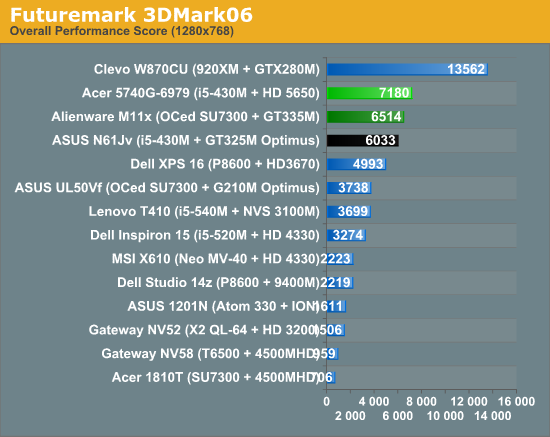
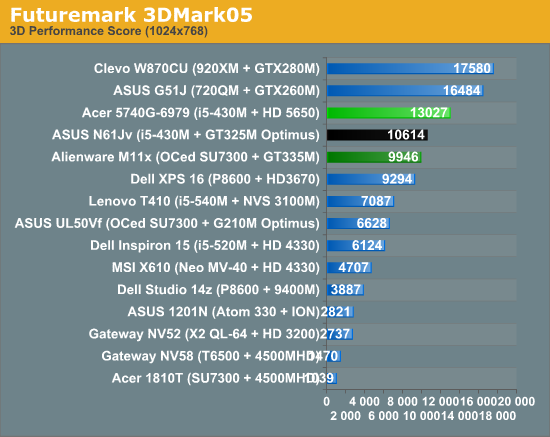
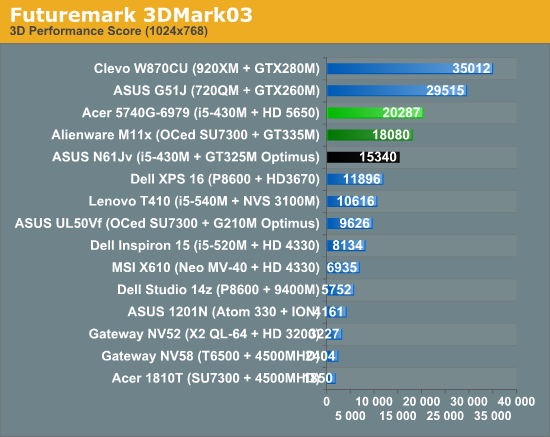
Despite the Inspiron 15's faster processor, it can't hold a candle to the Aspire's Radeon HD 5650. We expect the 5650 to deliver the same kind of performance in our gaming tests. The more interesting comparison for gamers is going to be the Alienware M11x, and here the HD 5650 shows its muster and beats the M11x by 10% to 30% in 03/05/06… but interestingly enough the M11x ends up being 20% faster in Vantage. Similarly, the 5740G beats the N61Jv by 20-30% in the older 3DMark suites, but the gap shrinks to 10% in Vantage. So which result should we trust? How about neither: we'll let actual gaming performance do the talking!
Our usual battery of gaming tests weren't enough of a workout for the Mobility Radeon HD 5650, so we've added results with it running at higher – and even maximized – settings. We want to see it stretch its legs as we turn all the settings up in modern games on the Aspire's 1366x768 screen. We've done the same with other laptops recently, but the only ones worth mentioning are the Alienware M11x with a GT335M GPU and the ASUS N61Jv with a GT325M. We'll include apples-to-apples results on those two laptops and high detail settings along with the minimum detail results for other lesser laptops. The green results are for low detail settings while the red results are at comparable "high" settings (which varies by game); other results for the 5740G are in gold and orange.
We run built-in benchmarks on Batman: Arkham Asylum, Crysis: Warhead, DiRT 2, Far Cry 2, and S.T.A.L.K.E.R.: Call of Pripyat, while Empire: Total War and Mass Effect 2 are measured in FRAPS by repeating a section. In each case, the Aspire has produced playable if not downright exceptional performance for a mainstream laptop.
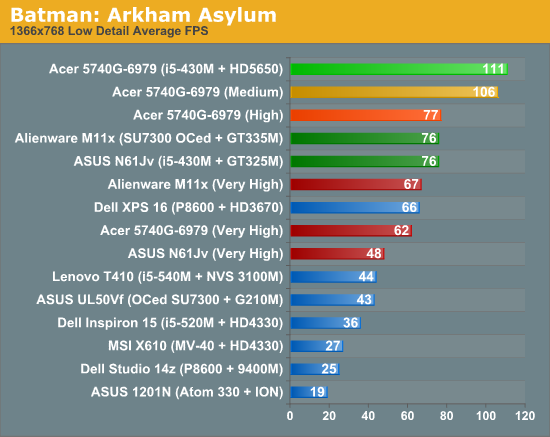
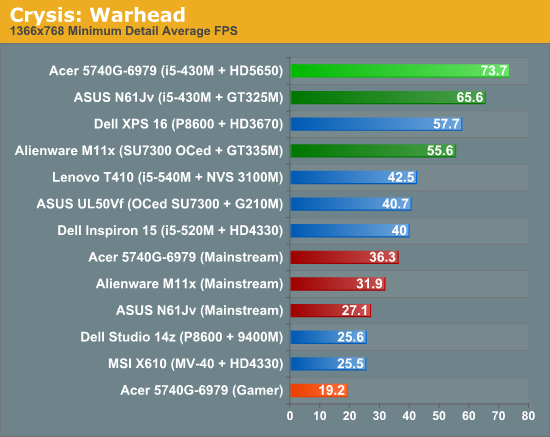
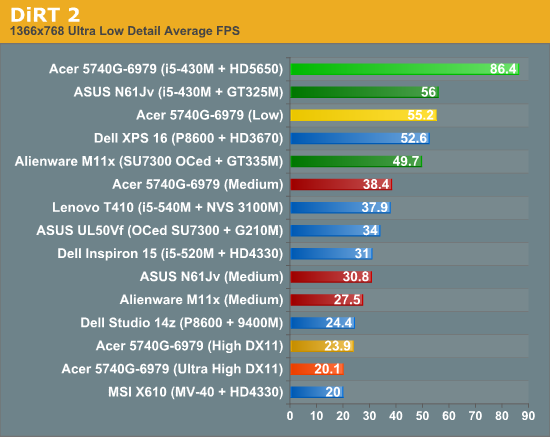
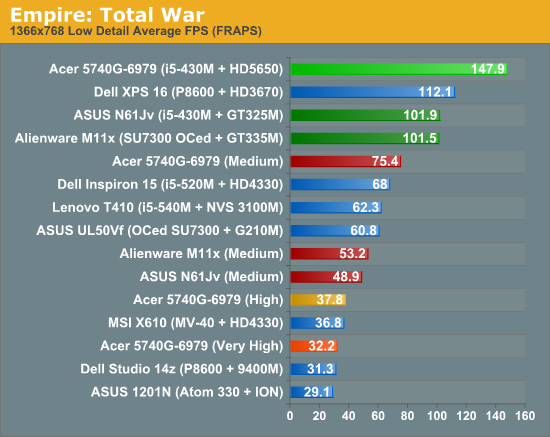
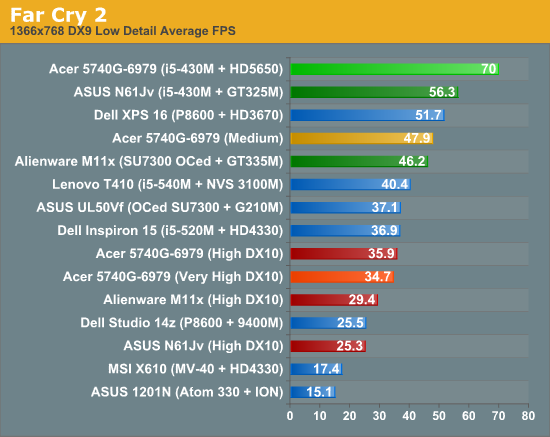
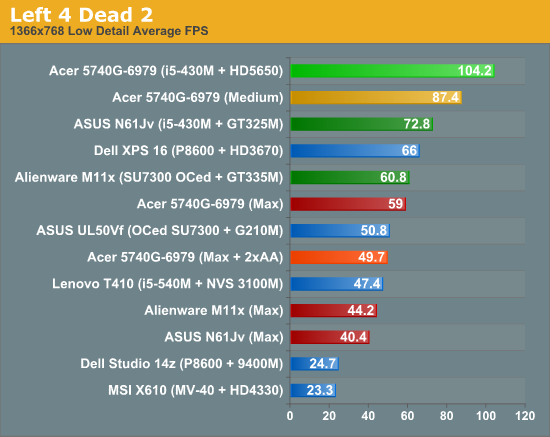
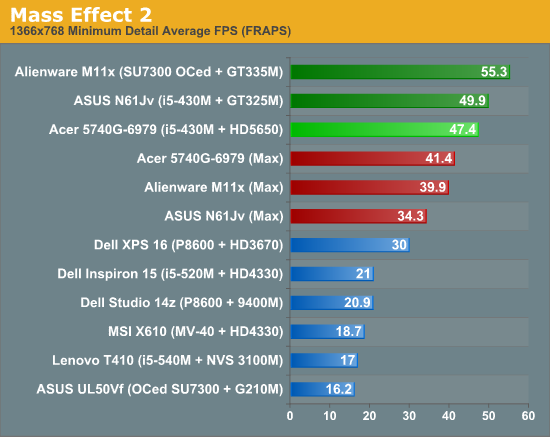

The minimum quality settings we normally compare at are largely academic for a system this fast. Nearly every game in our test suite was comfortably playable at maxed settings – without anti-aliasing – on the ATI Mobility Radeon HD 5650. The only outliers are the usual suspects: Crysis Warhead is still a monster on desktop cards, so getting it playable at even Mainstream settings across the board was impressive enough. Far Cry 2 can also be notoriously hard on mobile graphics, but bumping it up to DirectX 10 mode results in a reasonably enjoyable experience.
And then there's DiRT 2 and S.T.A.L.K.E.R.: Call of Pripyat bringing some DirectX 11 to the table. Other reviews of the Radeon HD 5000 series desktop hardware have proven DirectX 11-capability for anything under the 5700s is largely academic, and though Call of Pripyat is quite playable with some settings turned down, DirectX 11 at maximum detail just isn't in the cards. DiRT 2 is a similar story, with medium detail producing a very palatable 38FPS; bump the detail to High or Ultra High and performance takes a dive.
Compared to the closest competition, we do see a few titles where differences in drivers or other features plays a role. The M11x beats the 5740G—despite having a much slower CPU—in Batman and Stalker at high quality settings, as well as Mass Effect 2 at minimum settings. Mass Effect 2 also runs faster on the N61Jv at minimum settings, but since all three laptops can easily handle maxed out settings it's still a game that the 5740G wins. Looking at overall averages, at minimum detail the 5740G is 45% faster than the M11x and bumping the games to higher quality settings still leaves the Acer laptop with a 17% lead. Not surprisingly, the N61Jv is quite a bit slower at high details settings: the 5740G leads by 34% on average; low detail settings narrow the gap slightly with the N61J with the Acer lead shrinking to 29%.
With the mainstream GPU, there's an expected need for more robust cooling, which can bring about more noise. Thankfully, the fan in the Aspire 5740 isn't terribly loud. You may want headphones anyhow, but the speakers should be able to drown things out well enough to get you into the game without too much trouble.
Acer advertises the six-cell, 46Wh battery included with the Aspire 5740 as being able to produce roughly three hours of running time on the battery and in our experience, if you did absolutely nothing but leave the machine idle, you could achieve it. Very light office loads (i.e. typing in Word) should also manage close to three hours. We tested the battery with the computer's power profile set to “Power Saver” in Windows 7 and the screen brightness measured as close to 100nits as we could get it. In the case of the 5740G, a brightness setting of 40% (three steps up from minimum or six steps down from maximum) gave us 110nits, but the next step down dropped us to 80nits so we stuck with the 40% setting.
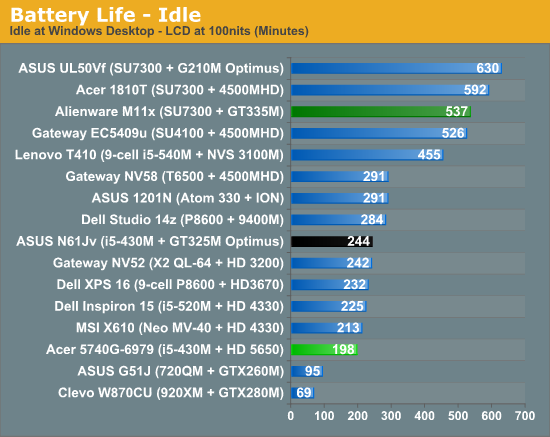
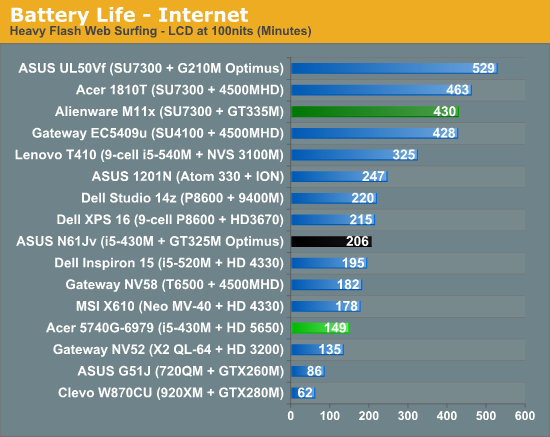


AMD may have tuned the Mobility Radeon HD 5650 to sip power at idle, but it's still consuming power. Coupling it with one of the lowest-rated batteries we've had in a review unit results in battery life that may not be along the lines of the glorified UPS systems found in big desktop replacement gaming notebooks but still isn't winning any prizes. Only our (outdated) test machines with AMD processors produce consistently lower battery life results, and even then they're still in the same ballpark as the Aspire 5740. The 46Wh battery just can't keep up, and battery life under any kind of use cuts at least a half hour to a full hour off the unit's running time.
Of course, the GPU isn't the only culprit in these tests. NVIDIA's Optimus Technology allows dynamic switching between discrete and integrated graphics, and the N61Jv comes with a similar 6-cell 48Wh battery, as does the Dell Inspiron 1564. The N61Jv is a best-case result for current i5 processors, and it delivers 20% to 40% more battery life (average around 30%) than the 5740G. With an older and slower HD 4330, the Inspiron 15 also beats the 5740G, but only by 10%~30% (average ~20%). If you're looking for good battery life, short of stuffing a huge 94Wh battery into a laptop (i.e. the ThinkPad T410 results) we need a less power-hungry CPU. We have yet to test any Arrandale CULV processors, but it looks like that's what we'll really need to keep Core i5/i7 CPUs out of the red zone for battery life.
The screen on the Aspire, at least at first glance, isn't terrible, but it's definitely bargain quality—just like most other consumer laptops. Some minor color banding can actually be seen under certain circumstances, and there's a “screen door” effect that's a little more pronounced than we're used to seeing. Our standard, more formal tests on the Acer Aspire 5740's 15.6” LCD screen were run using ColorEyes Display Pro. For comparison, we've highlighted the Dell Studio XPS 16 RGB LED results as the current "gold standard" for high quality LCDs.
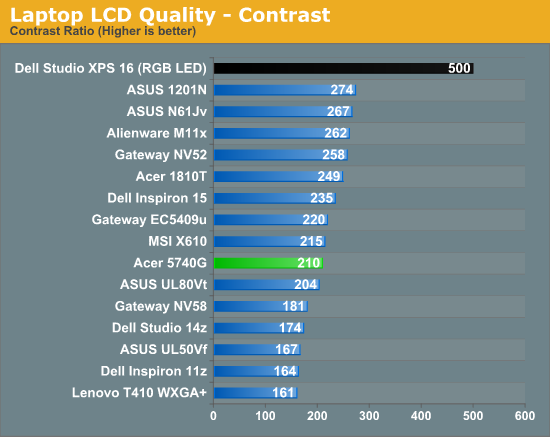
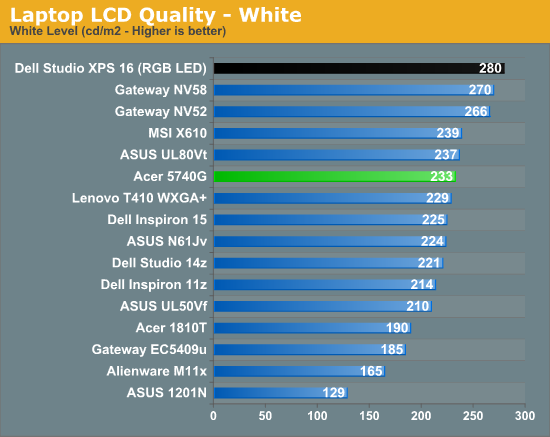
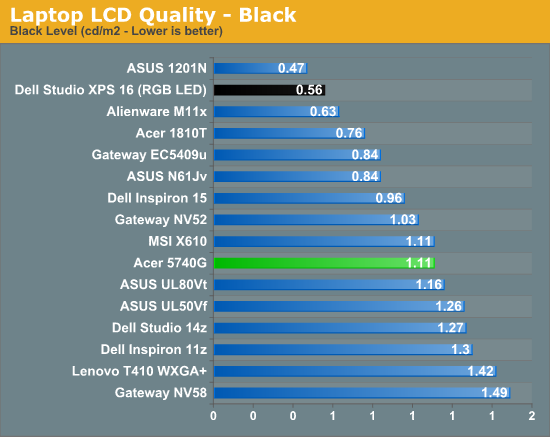
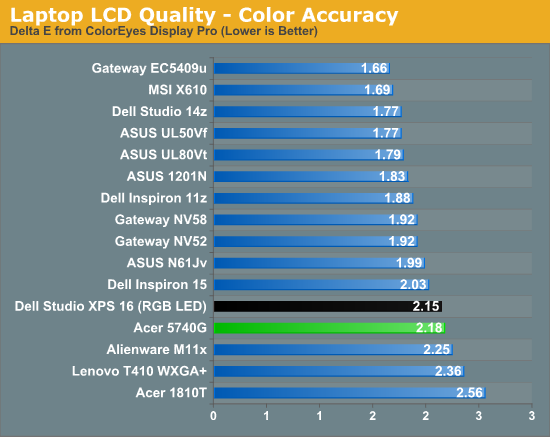

Really, there's nothing worth discussing here that we haven't already said on numerous occasions. Glossy, highly reflective displays with low contrast ratios and generally poor colors aren't going to win any LCD quality awards. The 5740G is right near the bottom in terms of contrast ratio, but a bit higher on the color gamut test. After seeing great results with the ASUS 1001p netbook (and we'll tell a similar story with the upcoming ASUS G73J review), we know that it's possible to get better LCDs than what we've been seeing. Unfortunately, BOM costs make LCD panels one area where just about every manufacturer is keen to save some money, including higher end offerings from Lenovo and Alienware. To reiterate, please, stop the madness!
Above you can see the viewing angles of the LCD. They're no worse than other TN panels, really, but notice the "screen door" effect on the straight-on shot; it's definitely more visible than on other laptops.
At the end of the day, the major point to make about the Acer Aspire 5740-6979 is the one we've made repeatedly throughout the course of this review: this thing's available for just $749. The mobile gamer on a budget would be hard-pressed to find a better combination of specifications anywhere else. Other manufacturers are packing much less powerful GPUs in their notebooks in this price range, and that's assuming there's even a dedicated GPU at all. If gaming is your primary concern and money's tight, your decision is already made: you simply will not find a better combination of performance and price on the market. Bar none. The 2.26 GHz Intel Core i5 and powerful Mobility Radeon HD 5650 make this thing a steal at its asking price.
If, however, all things aren't entirely equal, you may want to ask yourself which sacrifices you're willing to make to get this much gaming power. The Aspire 5740G is bulky but not horrendously so, but the battery life is mediocre and the keyboard is going to make or break the notebook for some users. You're going to want to venture out into retail land – where Acer thankfully has a very strong presence – and check out the chassis and keyboard to see if they're compromises you can live with to get to the juicy, delicious performance-class components inside.
The other sacrifice for many users is going to be connectivity. Personally, the Aspire 5740 was all aces at first glance, but a lack of FireWire takes it out of contention for a great deal of multimedia work. Like the Dell Inspiron 15 we recently reviewed, omitted ports wouldn't be such a hassle if there was at least some kind of remedy available in the form of an ExpressCard slot. There isn't one. What you see is what you get with the Aspire 5740.
What we're left with is price, and Acer has made this mightily compelling. If you can handle the dreadful keyboard, the mediocre battery life, and the somewhat cheap-looking build, you'll find yourself with a heck of a machine for the money. The Mobility Radeon HD 5650 delivers plenty of gaming prowess that should last the earnest gamer for some time to come, and the Core i5-430M ensures games present and future won't be horribly starved for processor power. Bottom line: if all you're after is how much computer you can get under the hood for as little money as possible, Acer's Aspire 5740G is hands down the best laptop deal on the market.

